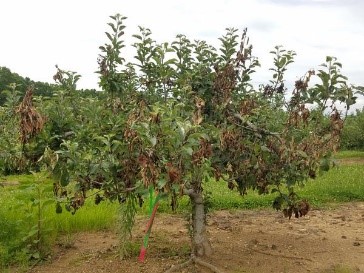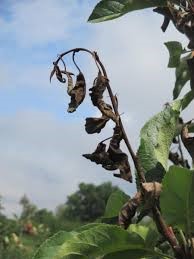Fire Blight on Apples
go.ncsu.edu/readext?696461
en Español / em Português
El inglés es el idioma de control de esta página. En la medida en que haya algún conflicto entre la traducción al inglés y la traducción, el inglés prevalece.
Al hacer clic en el enlace de traducción se activa un servicio de traducción gratuito para convertir la página al español. Al igual que con cualquier traducción por Internet, la conversión no es sensible al contexto y puede que no traduzca el texto en su significado original. NC State Extension no garantiza la exactitud del texto traducido. Por favor, tenga en cuenta que algunas aplicaciones y/o servicios pueden no funcionar como se espera cuando se traducen.
Português
Inglês é o idioma de controle desta página. Na medida que haja algum conflito entre o texto original em Inglês e a tradução, o Inglês prevalece.
Ao clicar no link de tradução, um serviço gratuito de tradução será ativado para converter a página para o Português. Como em qualquer tradução pela internet, a conversão não é sensivel ao contexto e pode não ocorrer a tradução para o significado orginal. O serviço de Extensão da Carolina do Norte (NC State Extension) não garante a exatidão do texto traduzido. Por favor, observe que algumas funções ou serviços podem não funcionar como esperado após a tradução.
English
English is the controlling language of this page. To the extent there is any conflict between the English text and the translation, English controls.
Clicking on the translation link activates a free translation service to convert the page to Spanish. As with any Internet translation, the conversion is not context-sensitive and may not translate the text to its original meaning. NC State Extension does not guarantee the accuracy of the translated text. Please note that some applications and/or services may not function as expected when translated.
Collapse ▲Fire blight is a devastating bacterial disease that can infect flowers, current year shoots, and the rootstock of apple trees. Other trees and shrubs that can contract fire blight includes pear, quince, cotoneaster, hawthorn, serviceberry, and crabapple. Unfortunately, this spring’s wet, cool weather has been conducive to fire blight; which is caused by a bacterium (Erwinia amylovora). It can spread quickly when environmental conditions are right for disease development.
Flower blossoms or wounds are entry points the bacteria use to get into the plant. Any blossom will continue to be susceptible to fire blight as long as it has intact petals. Wounds can be inflicted by man but also wind or hail The infected flowers or leaves turn black and then die. As the bacteria moves down the branch, young twigs blacken and curl. The leaves will wilt and blacken as well, but they remain on the branch. This gives the plant a fire-scorched appearance. Sometimes this is described as looking like a shepherd’s hook. Cankers appear on the branches and the main stem. The disease can be spread from plant to plant by insects and rain. Sadly, there is no cure for fire blight. The old saying “An ounce of prevention is worth a pound of cure,” definitely applies here.
There are varieties that are less susceptible to fire blight. Choose these when possible. Avoid excessive nitrogen applications that promote new plant growth that is susceptible to disease. An early spring preventive spray with streptomycin or copper-based fungicides may be necessary for commercial orchard settings.
In general, the cost and effort are not feasible fore most homeowners. Trees need to be sprayed at a 3-4 day interval during bloom and the entire leaf canopy must be treated for control. Most homeowners help reduce the spread of the disease by implementing good sanitation practices. All affected plant parts should be removed and destroyed. If infected plant parts are not removed from the site, there is a great possibility that the bacterium can reinfect the tree or infect other susceptible trees nearby. Wait to prune until the window for disease development is past. It is best to prune on the driest and coolest day possible during the summer or during the winter dormant season. All blighted shoots should be pruned into last year’s growth, or at least 12 inches below the last visible sign of necrosis which causes leaves, stems and other parts to darken and wilt. Sanitize pruning shears between each cut. Pruners can be dipped into a 10 percent household bleach or Lysol to reduce the risk of transmitting the disease. If the cankers are left on the tree, they will continue to spread each season.






